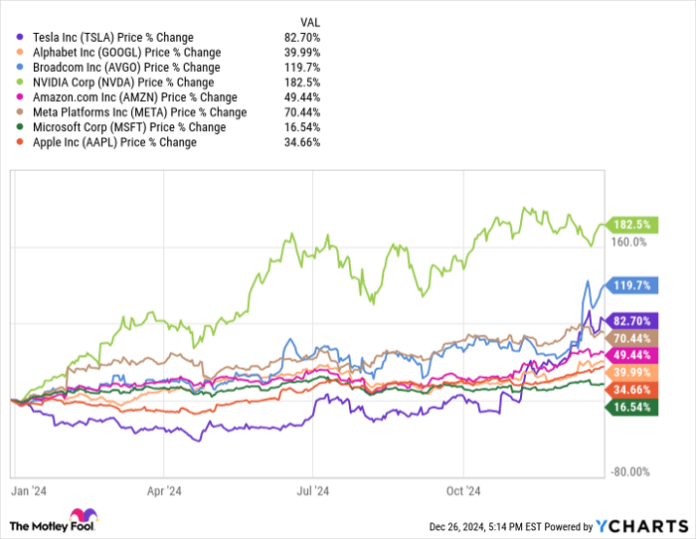Understanding the High Influence of the S&P 500’s Fateful Eight
The S&P 500 index serves as a key indicator for the overall U.S. stock market. This index comprises 500 major companies across various sectors, reflecting both value and growth investment categories. Together, they represent roughly 80% of the U.S. stock market’s total value, making the S&P 500 a reliable market proxy.
However, the index’s structure means that a company’s weight is determined by its market capitalization. In recent years, a small number of firms have grown significantly, leading to a situation where just eight companies now account for more than one-third of the S&P 500’s total value.
Start Your Mornings Smarter! Receive the latest market news with Breakfast news delivered to your inbox every market day. Sign Up For Free »
Meet the Fateful Eight
It’s no secret that the overall market has seen increasing concentration in recent times. Stocks related to technology and artificial intelligence have surged, significantly boosting the index, which has experienced a gain of approximately 26% in 2024 (as of December 27). Over the past two years, the S&P 500 has risen over 55%. Currently, the following eight companies make up about 34.4% of the index:
1. Apple (NASDAQ: AAPL): 7.66%
2. Nvidia (NASDAQ: NVDA): 6.71%
3. Microsoft Corp (NASDAQ: MSFT): 6.37%
4. Amazon (NASDAQ: AMZN): 4.16%
5. Meta Platforms (NASDAQ: META): 2.57%
6. Tesla (NASDAQ: TSLA): 2.48%
7. Alphabet (NASDAQ: GOOGL) (NASDAQ: GOOG): 2.24%
8. Broadcom (NASDAQ: AVGO): 2.24%
Initially labeled the “Magnificent Seven,” these companies have made headlines for their substantial market influence, robust balance sheets, and technological advancements. Recently, Broadcom’s market capitalization crossed the $1 trillion threshold, prompting analysts to include it in this elite group, now referred to as the “Fateful Eight.” Their performance has been notably strong this year, with one minor exception.

TSLA data by YCharts.
This year, every stock in the Fateful Eight, except for Microsoft, has outperformed the broader S&P 500. In fact, these companies have at least doubled the index’s gains. However, it’s noteworthy that 168 stocks within the S&P 500 have declined this year, with over 70% of the index lagging behind overall market performance.
Is the Market Increasingly Risky?
With so much of the S&P 500’s gains coming from a small number of companies, some investors may question the safety of investing in the broader market. Many stocks in the Fateful Eight are currently trading at elevated valuations, making them vulnerable should they post poor earnings or fail to meet forecasts, especially if inflation begins to rise again. After all, Treasury yields have been increasing, and investors have tempered expectations for interest rate cuts in 2025.
There is a belief that the market’s gains may eventually extend to a wider array of stocks. Should the high valuations of the Fateful Eight stabilize, other S&P 500 companies, typically traded at more reasonable valuations, could see growth that offsets any declines in these tech giants. However, some market analysts are now viewing these big tech stocks as defensive investments, predicting that in a high-inflation environment with limited interest rate reductions, investors might prioritize safer options in the Fateful Eight.
The dynamics at play here are certainly intriguing and complex. Investors should be aware that current metrics indicating broader market performance are not as diversified as they historically have been. Thus, the S&P 500’s significant reliance on these tech mega-caps presents a risk for a potential downturn. The specter of renewed inflation and a possible recession looms, even if economic indicators do not currently suggest an imminent downturn.
For those worried about concentration risks in the S&P 500, one strategy might be to consider investing in funds like the Invesco S&P 500 Equal Weight ETF (NYSEMKT: RSP).
This fund rebalances quarterly, ensuring each of its holdings maintains an equal share rather than being weighted by market cap. Although equal-weighted funds have underperformed traditional S&P 500 funds this year, they could prove to be more resilient if the Fateful Eight experience a downturn, or if market growth shifts towards recently underperforming stocks.
A New Opportunity Awaits
Have you ever felt like you missed out on investing in phenomenal stocks? If so, you’ll want to take note.
Our team of analysts has identified rare “Double Down” stock opportunities—companies they believe are poised for significant growth. If you’re concerned that the best investment windows have passed, now may be the ideal time to invest before the next surge. The historical returns illustrate the potential:
- Nvidia: An investment of $1,000 when we first recommended it in 2009 would now be worth $355,269!*
- Apple: A $1,000 investment at the time of our 2008 recommendation would be worth $48,404!*
- Netflix: If you invested $1,000 at our 2004 recommendation, you’d now have $489,434!*
Currently, we are signaling “Double Down” alerts for three remarkable companies, and this opportunity may not last long.
See 3 “Double Down” stocks »
*Stock Advisor returns as of December 23, 2024
Suzanne Frey, an executive at Alphabet, is a member of The Motley Fool’s board of directors. John Mackey, former CEO of Whole Foods Market, an Amazon subsidiary, is a member of The Motley Fool’s board of directors. Randi Zuckerberg, a former director of market development and spokeswoman for Facebook and sister to Meta Platforms CEO Mark Zuckerberg, is a member of The Motley Fool’s board of directors. Bram Berkowitz has no position in any of the stocks mentioned. The Motley Fool has positions in and recommends Alphabet, Amazon, Apple, Meta Platforms, Microsoft, Nvidia, and Tesla. The Motley Fool recommends Broadcom and recommends the following options: long January 2026 $395 calls on Microsoft and short January 2026 $405 calls on Microsoft. The Motley Fool has a disclosure policy.
The views and opinions expressed herein are the views and opinions of the author and do not necessarily reflect those of Nasdaq, Inc.

